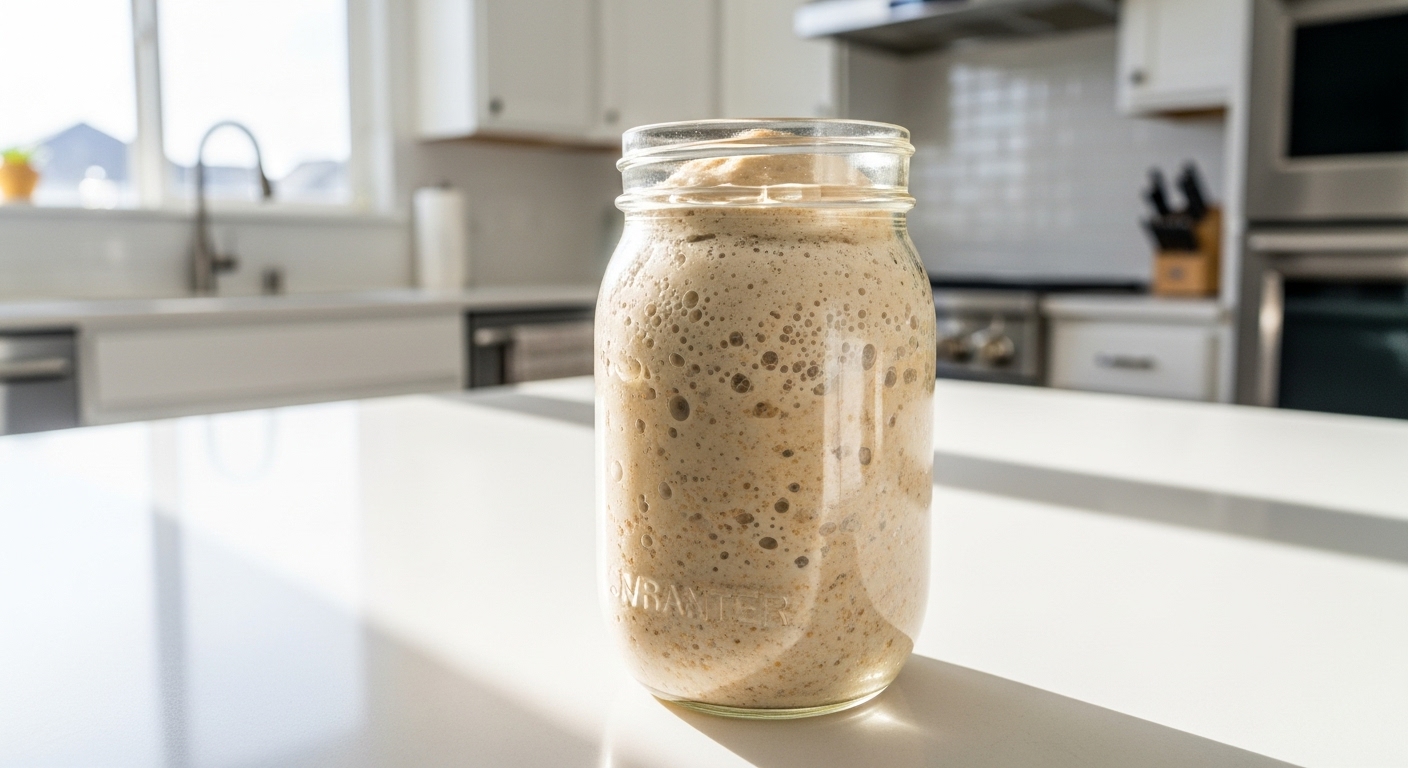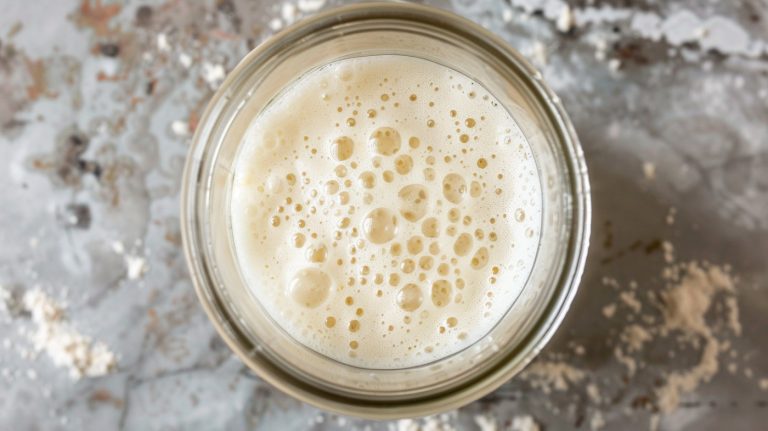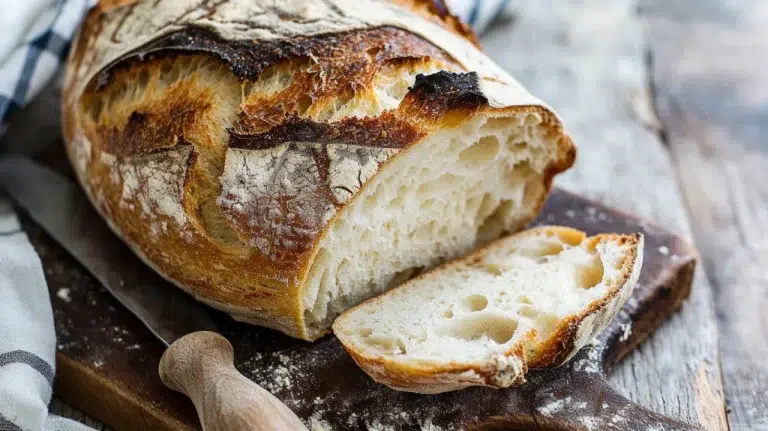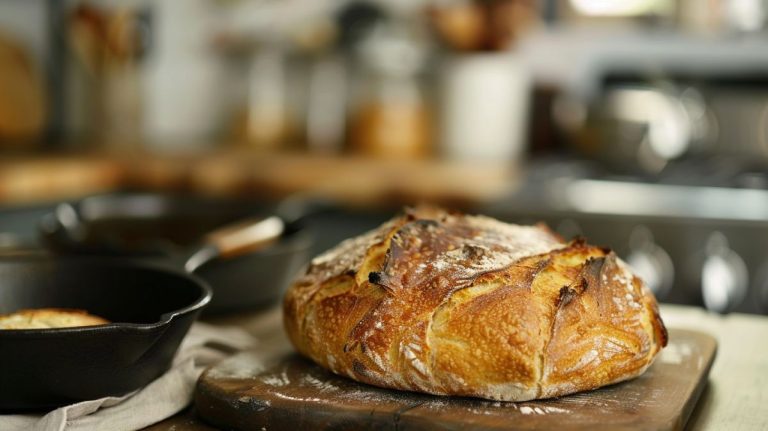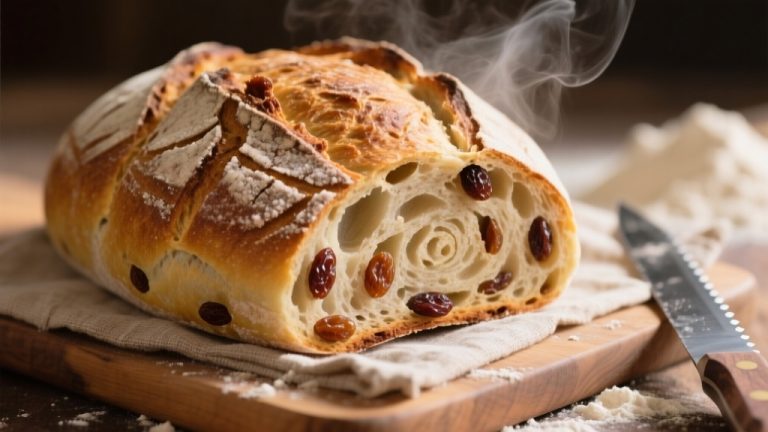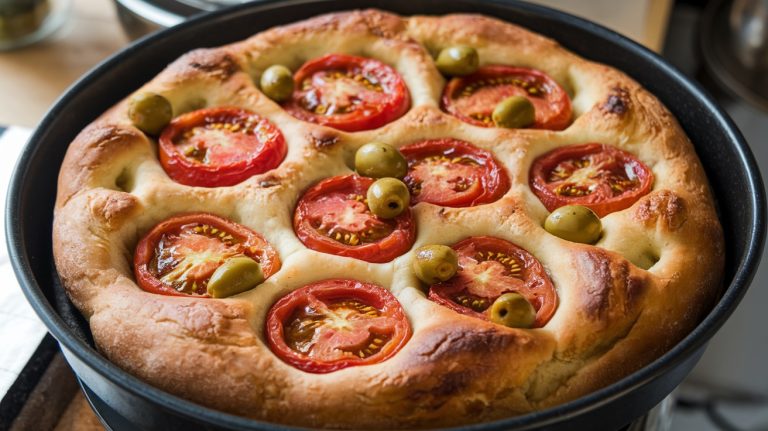Peaked Sourdough Starter: Capture the Magic Moment
When your sourdough starter peaks—usually 4 to 8 hours after feeding at 75°F–82°F—it’s doubled in volume, bubbly, and has a tangy aroma, indicating maximum yeast and bacterial activity. This peak marks ideal CO₂ production, suitable acidity, and strong gluten development, yielding superior rise and flavor.
Using it slightly past peak enhances sourness but reduces leavening strength. Mastering these visual and sensory cues lets you time feedings precisely to improve your bread’s texture and taste.
Key Takeaways
- A peaked sourdough starter shows doubled volume, visible bubbles, a loose texture, and a pleasant sour aroma indicating maximum fermentation.
- Peak timing usually occurs 2 to 8 hours after feeding, influenced by temperature, hydration, and feeding ratios.
- Ideal peak temperature is 75°F–82°F, optimizing yeast and bacterial activity for consistent CO₂ production and flavor development.
- The float test confirms peak readiness by showing high CO₂ content through buoyant starter samples.
- Using starter at peak ensures optimal rise, balanced acidity, strong gluten, and the best flavor in sourdough baking.
Definition and Key Characteristics of a Peaked Sourdough Starter
When your sourdough starter reaches its peak, it means it’s at the height of fermentation activity, having doubled or more in volume and filled with abundant visible bubbles.
This stage marks the shift from exponential microbial growth to the stationary phase, with yeast and lactic acid bacteria populations at their maximum. For optimal bread texture, consistent kneading with the right mixing techniques helps in developing gluten properly.
You’ll notice a loose, aerated texture in liquid starters, while stiff starters exhibit a flattened dome with a soft, crackled surface. The starter emits a distinct sour aroma due to lactic acid production and passes the float test, indicating high CO2 content.
Biochemically, sugars are efficiently metabolized into ethanol, acids, and carbon dioxide, lowering pH but not yet inhibiting activity. This peak signals ideal leavening power before microbial activity begins to decline. Using a starter slightly past its peak can still produce quality bread and offers flexibility in sourdough management.
Timing and Duration to Reach Peak Activity
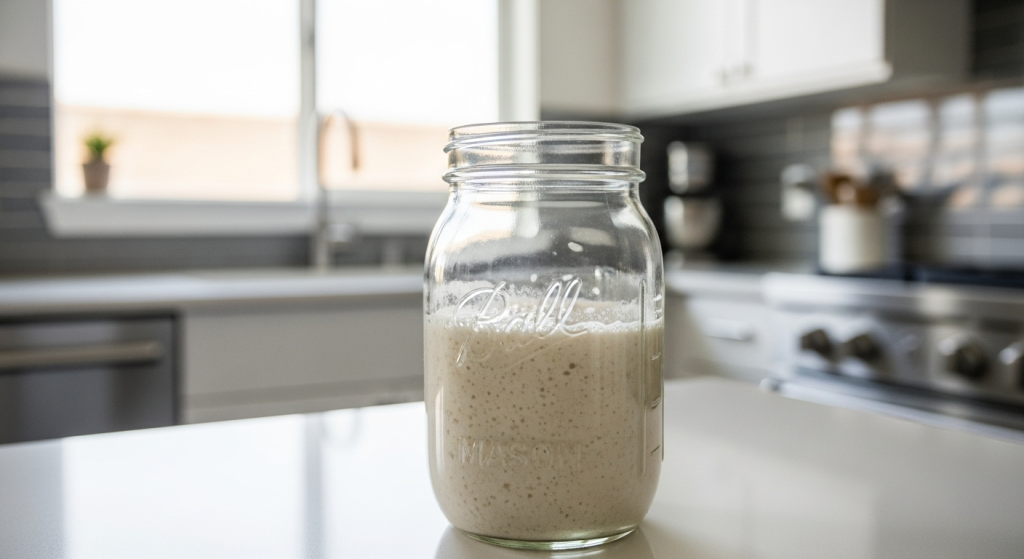
You’ll typically see your starter reach peak activity between 2 to 8 hours post-feeding, depending largely on ambient temperature and hydration levels. Choosing the right measurement precision for your baking scale can help you replicate these conditions consistently.
Warmer conditions accelerate yeast metabolism, cutting peak time to as little as 4 hours, while cooler environments extend it.
Adjusting hydration and feeding ratios also influences fermentation speed, allowing you to fine-tune the timing for ideal leavening power.
Typical Peak Time
Although peak time varies with environmental and feeding conditions, a mature sourdough starter typically reaches its maximum activity between 2 to 4 hours after feeding under standard room temperatures and moderate feeding ratios. Many advanced bread makers provide programmable delay timers that help bakers align peak starter activity with their baking schedule.
To manage your starter’s timing precisely, consider these factors:
- Feeding ratio: A 1:1:1 ratio peaks around 3-4 hours, while larger ratios like 1:10:10 can delay peak up to 10-12 hours due to slower yeast population buildup.
- Starter maturity: Well-established starters with stable yeast communities peak faster than young or less active ones.
- Flour type: Whole wheat or rye flours accelerate peak time by providing more accessible sugars compared to all-purpose flour.
Using your starter at its peak activity ensures the yeast cells are most active, producing the optimal amount of carbon dioxide and ethanol to leaven your dough effectively.
Understanding these variables helps you predict and align your starter’s peak activity with your baking schedule efficiently.
Temperature Effects
Since temperature directly influences microbial metabolism, controlling it allows you to manage your sourdough starter’s timing and duration to reach peak activity with greater accuracy.
Maintaining your starter between 75°F and 82°F promotes vigorous yeast and bacterial fermentation, enabling it to peak predictably within 6 to 8 hours. Cooler environments below 68°F slow fermentation considerably, often doubling peak time due to microbial dormancy.
Conversely, excessive heat above 86°F accelerates fermentation but risks microbial imbalance, rapid peaking, and compromised starter health. Temperatures exceeding 120°F can kill yeast, halting activity entirely.
To guarantee consistent peak timing, stabilize ambient temperatures within the ideal range, avoiding fluctuations that disrupt microbial rhythms. Using proofing boxes or warm spots helps maintain this stability, optimizing fermentation kinetics and preserving starter vitality for reliable daily use.
Additionally, incorporating a thermometer sticker or temperature strip on your starter jar can help monitor and maintain optimal fermentation temperatures more effectively.
Hydration Influence
When adjusting your sourdough starter’s hydration, you directly influence the timing and duration needed to reach peak activity. Hydration, calculated as (water ÷ flour) × 100, dictates microbial metabolism rates and starter consistency.
Precise measurements are essential for consistent results in sourdough baking, as small variations in hydration levels can significantly alter fermentation behavior. Using a bulk fermentation container with proper size and airtight seal can help maintain consistent environmental conditions for your starter.
Here’s how hydration impacts peak timing:
- Higher hydration (>100%) creates a looser matrix, accelerating yeast fermentation and substrate diffusion, often shortening peak time to under 8 hours but risking collapse if over-fermented.
- At 100% hydration, starters balance yeast and bacteria growth, typically peaking between 8-12 hours, offering predictable rise and bubble formation.
- Lower hydration yields a stiff starter, slowing enzymatic activity and yeast mobility, extending peak time up to 24 hours and enhancing acetic acid bacteria, producing a more sour flavor.
Adjust hydration strategically to synchronize peak activity with your baking schedule and desired flavor profile.
Microbial Dynamics at the Peak Stage
At the peak stage, you’ll observe yeast populations actively fermenting sugars into carbon dioxide, driving dough expansion. Meanwhile, lactic acid bacteria proliferate, producing lactic and acetic acids that lower pH and inhibit unwanted microbes.
This dynamic balance between gas production and acid accumulation stabilizes the starter’s microbial ecosystem and defines its functional performance. The microbial community assembly at this stage involves complex interactions among competing species that shape the eventual stable community.
Similar to how temperature control in commercial pizza ovens influences microbial activity and product quality, maintaining optimal conditions is crucial for a thriving sourdough starter.
Yeast and Bacteria Growth
Although multiple microbial species initiate sourdough fermentation, the peak stage features a finely balanced community where a few yeast species dominate leavening by producing carbon dioxide, while lactic acid bacteria (LAB) remain diverse and actively acidify the environment. Practical kitchen tools such as pizza stones help optimize heat distribution, analogous to how microbial balance optimizes fermentation.
You’ll notice bacterial cells outnumber yeast by about 100:1 during peak activity, reflecting their metabolic dominance. This mutualism supports efficient sugar utilization and acid production, shaping starter characteristics.
These microbial communities are influenced not only by flour but also by the baker’s skin microbiota, indicating a bidirectional microbial exchange.
Key points to understand include:
- Yeast species specialize in fermenting sugars inaccessible to bacteria, enabling robust CO2 generation.
- LAB diversity sustains acidification, lowering pH to favor acid-tolerant microbes and suppress spoilage.
- The community stabilizes in the stationary phase, maximizing metabolic output critical for sourdough flavor and texture development.
Carbon Dioxide Production
How does carbon dioxide production reach its peak during sourdough starter fermentation?
At peak, yeast populations, including Saccharomyces cerevisiae and Candida milleri, metabolize flour carbohydrates via alcoholic fermentation, converting sugars into CO₂ and ethanol. This metabolic activity maximizes CO₂ output, producing gas bubbles trapped within the gluten matrix, inflating dough volume. The natural rattan proofing baskets used in fermentation help maintain optimal airflow and moisture, supporting consistent yeast activity.
CO₂ generation correlates directly with yeast cell density and activity, typically peaking 2-4 hours post-feeding under ideal temperature and hydration. Feeding ratios and starter maturity modulate substrate availability, influencing CO₂ rates. The diversity in starters can be linked to the microbiomes of bakers’ skin and the environment, which affects the microbial composition of the starter and consequently its fermentation dynamics.
Cooler temperatures slow yeast metabolism, extending peak timing. The diverse yeast species balance impacts overall CO₂ dynamics, with some species like S. servazzii producing more CO₂.
This microbial-driven CO₂ production phase is vital for dough aeration and rise, setting the stage for effective leavening before nutrient depletion slows fermentation. Proper proofing tools and environment also contribute to maintaining the ideal fermentation conditions necessary for maximum CO₂ production.
Acid Accumulation Effects
Since acid accumulates rapidly at the peak stage of sourdough starter fermentation, it directly suppresses microbial activity, especially fermentative bacteria and yeast. The lactic and acetic acids increase acidity, inhibiting further fermentation and slowing CO2 production.
Yeast cells enter dormancy rather than dying, halting metabolic activity until feeding dilutes acidity. This high acidity environment acts as a yeast growth inhibitor, significantly reducing starter strength. Proper humidity management during storage can help moderate acid buildup and extend starter viability.
- Acid accumulation activates protease enzymes, degrading gluten and weakening starter structure, causing it to collapse after peaking.
- Lactic acid bacteria dominate, shifting microbial balance and maintaining high acidity if feedings are infrequent or storage is warm.
- Reviving an acidic starter requires multiple feedings to reduce acid concentration, restore microbial activity, and regain fermentative strength.
You must manage acid buildup carefully to maintain a robust, active starter.
Visual and Sensory Indicators of a Peaked Starter
When your sourdough starter reaches its peak, you’ll notice a distinct set of visual and sensory indicators that signal ideal fermentation activity.
Visually, the starter has a flat top with visible, evenly distributed bubbles on the surface and jar sides, reflecting active gas production. It will have nearly doubled or tripled in volume and display a light, airy, fluffy texture with slight elasticity.
You may observe subtle surface divots, indicating the onset of decline. Using clear containers helps you observe these changes and expansion marks. Storing your starter in eco-friendly containers can support sustainable kitchen practices.
Sensory-wise, the aroma is tangy with mild acidity—never overly sour or vinegar-like. The texture feels slightly stretchy, signifying *best* gluten development. Avoid soapy or foul odors and excessive foam, which signal over-fermentation.
Together, these cues confirm your starter is at peak readiness, *ideal* for use before surface collapse begins.
Impact of Using Starter at Various Stages on Bread Quality
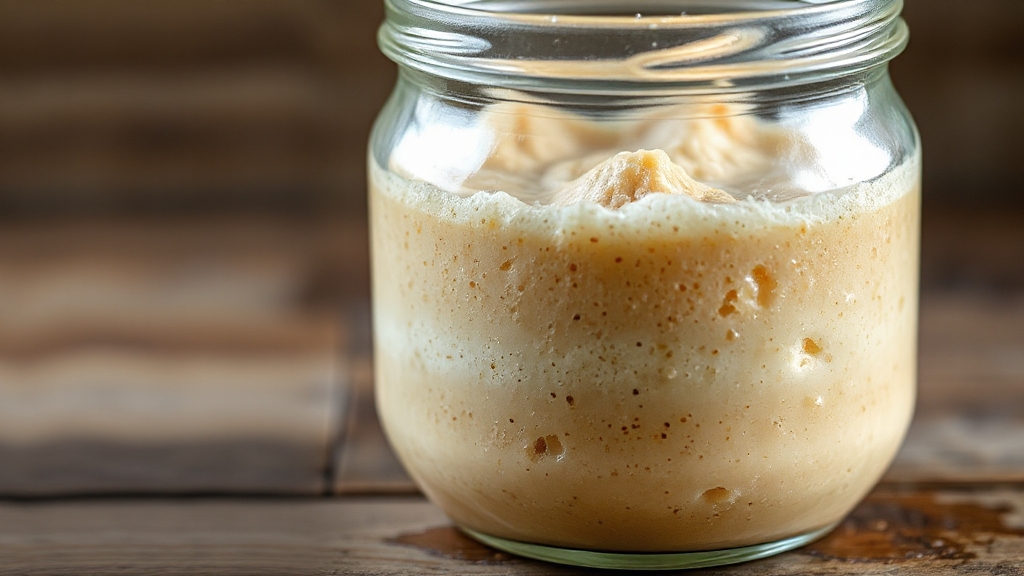
Recognizing your sourdough starter at its peak provides a reliable indicator of ideal fermentation activity, but understanding how using the starter at different stages affects bread quality can refine your baking outcomes. Your timing directly influences leavening power, crumb structure, and flavor complexity.
- Before Peak: Lower yeast activity slows fermentation, yielding denser crumb and milder flavor. Gluten support is weaker, potentially impacting extensibility, though extended bulk fermentation can compensate.
- At Peak: Yeast and bacteria are most active, delivering optimal rise, balanced acidity, and strong gluten development. This stage ensures open crumb and consistent, high-quality bread.
- Slightly Past Peak: Leavening remains effective with increased lactic acid, enhancing sour notes and dough extensibility. This stage can improve crumb tenderness and flavor depth without compromising structure.
Differences Between Liquid and Stiff Starters at Peak
Although both liquid and stiff sourdough starters reach their peak activity, their distinct hydration levels create significant differences in fermentation behavior, acid production, and microbial dynamics that directly influence bread characteristics and baking strategies.
Liquid starters ferment rapidly due to high hydration, producing milder lactic acidity and faster yeast activity, but their peak window is narrow. This higher hydration level typically corresponds to about 500% hydration, meaning five times more water than flour, which impacts fermentation dynamics. Stiff starters ferment slower, generate more acetic acid for complex sourness, and maintain peak stability longer, favoring robust flavor development.
| Aspect | Liquid Starter | Stiff Starter |
|---|---|---|
| Hydration | ≥100%, batter-like | 50–80%, dough-like |
| Fermentation | Fast, short peak | Slow, prolonged peak |
| Acid Profile | High lactic acid, mild sour | Higher acetic acid, sharp |
| Microbial Shift | Rapid yeast dominance | Bacteria favor low moisture |
| Baking Use | Quick breads, mild flavor | Long ferment, strong sour |
Techniques for Monitoring and Maintaining Peak Starter Health
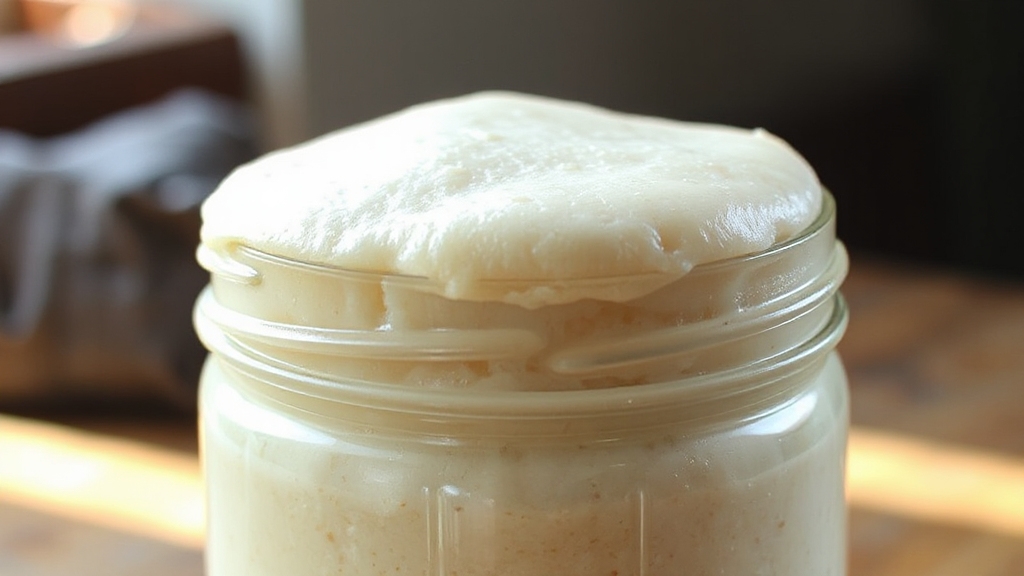
Maintaining peak starter health requires diligent monitoring of key indicators such as volume, aroma, and bubble formation to guarantee ideal fermentation activity. You’ll want to:
- Feed Consistently: Stick to a 12–24 hour schedule, adjusting for temperature and use frequency. Maintain a 1:4:4 starter-to-water-to-flour ratio by weight to ensure hydration balance and predictable fermentation. Experimenting with ratios helps find the optimal maintenance mix for your specific starter.
- Control Environment: Keep your starter at 75°F–80°F (24°C–26°C), avoiding drafts or extreme fluctuations. This stable temperature range optimizes yeast and bacterial activity, ensuring timely peaks.
- Monitor Signs: Track volume doubling by marking your jar, note a pleasant sour or fruity aroma, and confirm a network of bubbles and a slight dome or foam on the surface. These indicators confirm peak health and readiness for baking. Visual cues such as a flat surface by evening may indicate that the starter has passed its peak and fermentation is slowing.
Optimizing Bread Flavor and Texture With Peaked Starter Use
When you use a sourdough starter at its peak activity, you harness the maximum yeast population and ideal acidity levels that directly enhance both the flavor complexity and texture of your bread. At peak, yeast cells produce superior carbon dioxide, filling the gluten matrix and promoting superior dough rise and aeration.
This results in an open, airy crumb and robust oven spring. The peak-to-peak method, which involves discarding and refeeding the starter multiple times at its peak, helps to reduce acidity and strengthen the starter, ensuring optimal fermentation performance.
The balanced acidity at peak ensures nuanced tang without compromising fermentation speed, preserving gluten integrity and dough elasticity. Using starter too early or overripe leads to weak rise or over-acidification, which can degrade crumb structure.
To maximize these qualities, maintain consistent feeding ratios—typically 1:1:1 by weight—and monitor visual cues like tripling volume and a domed surface. This precision timing elevates both flavor depth and textural quality in your sourdough bread.
Frequently Asked Questions
Can I Freeze a Peaked Sourdough Starter for Later Use?
Yes, you can freeze your sourdough starter once it’s active and bubbly.
Feed it using filtered water, then portion it into small containers like silicone molds or ice trays.
Freeze overnight in airtight bags or containers to avoid freezer burn.
Label with the date.
When ready, thaw at room temperature or in the fridge, then feed it equal parts flour and water repeatedly until fully active again before baking.
How Do I Revive a Neglected Starter to Reach Peak Again?
Think of your neglected starter as a tired engine needing fresh fuel. Pour off any hooch to reduce acidity, then discard most starter, keeping 10-50g.
Feed it with a 1:4:4 ratio of starter, whole wheat or rye flour, and filtered lukewarm water.
Keep the jar at 75°F, feed every 12 hours, and watch for doubling and bubbling.
Repeat until vigorous activity returns, usually within 36 hours and two to three feedings.
What Are Common Mistakes That Prevent a Starter From Peaking?
You often prevent your starter from peaking by feeding it too infrequently, causing excessive acidity that weakens yeast activity. Overfeeding or discarding too much dilutes it, reducing strength.
Using inconsistent or poor-quality flour, incorrect hydration ratios, or ignoring temperature consistency also stalls peak development.
Misinterpreting hooch presence leads to improper feeding timing.
Finally, storing starters in airtight containers or failing to monitor bubble activity and smell limits your ability to adjust care for ideal peak performance.
Does Altitude Affect the Timing of a Sourdough Starter Peak?
Yes, altitude definitely affects your sourdough starter’s peak timing. At higher elevations, lower air pressure speeds up fermentation, causing your starter to peak faster—often within 2 to 4 hours after feeding.
To manage this, you’ll need to adjust feeding ratios and hydration, since dry air and drier flour at altitude impact starter consistency. Reactively tweaking feeding schedules and monitoring peak times help you maintain starter health and consistent fermentation despite altitude changes.
Can Additives Like Sugar or Oil Alter Peak Fermentation?
You might think adding sugar or oil could speed up fermentation, but it’s more nuanced. Sugar provides extra food, accelerating yeast activity and causing a faster peak, yet excessive amounts can exhaust your starter prematurely and upset microbial balance.
Oil doesn’t feed microbes and may actually slow fermentation by limiting gas exchange.
Instead, focus on temperature, feeding ratios, and flour type to reliably control peak timing without risking starter health.
Timing Is Everything—Track the Superior Rise and Flavor
When your sourdough starter peaks—typically within 4 to 6 hours after feeding—its yeast and lactobacilli populations reach ideal activity, boosting leavening power by up to 40%. Using the starter at this precise moment enhances bread’s rise, crumb structure, and flavor complexity.
By closely monitoring visual cues like domed peaks and subtle sour aromas, you guarantee consistent fermentation performance. Mastering this timing is key to professional-quality sourdough with superior texture and taste every bake.

